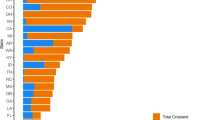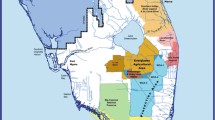Abstract
The Conservation Reserve Program (CRP), initiated by the Conservation Title of the Food Security Act of 1985, is the primary federal program to control nonpointsource pollution in agricultural watersheds of the United States. However, the program is designed primarily to reduce soil erosion rather than to retire croplands in a manner optimal for controlling runoff of sediment and associated pollutants. This study estimates potential enrollment of streamside and floodplain croplands in this ten-year retirement program in order to gauge the potential of the CRP as a water-quality improvement policy. A contingent choice survey design was employed in Fayette County, Illinois, to demonstrate that there is substantial potential for retirement of streamside and floodplain croplands in the CRP. Enrollments in each program climb from less than 6% to over 83% of eligible croplands as the annual rental rate is increased from $20 to $200/acre. Potential retirement of streamside and floodplain croplands declines, however, if tree planting, drainage removal, or a 20-year contract are required. The potential of a CRP-based water-quality program to improve water quality and aquatic ecosystems in agricultural watersheds is thus substantial but constrained by the economic trade-offs that farmers make between crop production and conservation incentives in determining the use of their riparian lands.
Similar content being viewed by others
Literature Cited
Clark, E. H., II, J. A. Haverkamp, and W. Chapman. 1985. Eroding soils: The off-farm impacts. The Conservation Foundation, Washington, DC.
Cooper, J. R., J. W. Gilliam, R. B. Daniels, and W. P. Robarge. 1987. Riparian areas as filters for agricultural sediment.Soil Science Society of America Journal 51:416–420.
Dillman, D. A. 1977. Mail and telephone surveys: The total design method. John Wiley & Sons, New York.
Esseks, J. D., and S. Kraft. 1990. Participation of eligible landowners in the Conservation Reserve Program: Results and implications of survey research, 1986–1988. Pages 223–237in T. L. Napier (ed.), Implementing the conservation title of the Food Security Act of 1985. Soil and Water Conservation Society, Ankeny, Iowa.
Gianessi, L. P., and H. M. Peskin. 1981. Analysis of national water pollution control policies: 2. Agricultural sediment control.Water Resources Research 17(4):803–821.
Hoehn, J. P., and A. Randall. 1987. A satisfactory benefit cost indicator from contingent valuation.Journal of Environmental Economics and Management 14:226–247.
Hynes, H. B. N. 1970. The ecology of running waters. University of Toronto Press, Toronto, Canada.
Iverson, L. R. 1989. Forest resources of Illinois: An atlas and analysis of spatial and temporal trends. Illinois Natural History Survey, Champaign.
Jacobs, T. C., and J. W. Gilliam. 1985. Riparian losses of nitrate from agricultural drainage waters.Journal of Environmental Quality 14:472–478.
Karr, J. R., and I. J. Schlosser. 1978. Water resources and the land-water interface.Science 201:229–234.
Karr, J. R., L. A. Toth, and D. R. Dudley. 1985. Fish communities of Midwestern rivers: A history of degradation.Bioscience 35:90–95.
Lant, C. L. 1989. Employing the Conservation Reserve Program to control agricultural water pollution. Pages 143–151in Papers and proceedings of the applied geography conferences. Binghamton, New York.
Lant, C. L., and G. A. Tobin. 1989. Determination of the economic value of riparian corridors on Cornbelt floodplains: A research framework.The Professional Geographer 41(3):337–349.
Larson, G. 1988. Implementing CRP: A state/local perspective.Journal of Soil and Water Conservation 43(1):16–18.
McElfish, J. M., Jr., and K. J. Adler. 1990. Swampbuster implementation: Missed opportunities for wetland protection.Journal of Soil and Water Conservation 45(3):383–385.
Menzel, B. W., J. B. Barnum, and L. M. Antosch. 1984. Ecological alterations of Iowa prairie-agricultural streams.Iowa State Journal of Research 59(1):5–30.
Ogg, C. W. 1986. Erodible land and state water quality programs: A linkage.Journal of Soil and Water Conservation 41(6):371–373.
Peterjohn, W. T., and D. L. Correll. 1984. Nutrient dynamics in an agricultural watershed: observations on the role of a riparian forest.Ecology 65:1466–1475.
Purvis, A., J. P. Hoehn, and V. Sorensen. 1990. Farmer’s willingness to supply land as filter strips: Evidence from a Michigan survey. Pages 187–201in T. L. Napier (ed.), Implementing the Conservation Title of the Food Security Act of 1985. Soil and Water Conservation Society, Ankeny, Iowa.
Ribaudo, M. O. 1986. Consideration of off-site impacts in targeting soil conservation programs.Land Economics 62(4):402–411.
Smolen, M. D., K. S. Adler, A. L. Lanier, D. L. Hoag, and D. W. Miller. 1988. Interfacing nonpoint source programs with the Conservation Reserve: Guidance for water quality managers. US Environmental Protection Agency, Office of Water Regulations and Standards, Washington, DC.
USDA (Department of Agriculture). 1989a. Conservation Reserve Program: Progress report and preliminary evaluation of the first two years. January 1989.
USDA (Department of Agriculture). 1989b. The second RCA appraisal. June 1989.
USDA (Department of Agriculture). 1990. Conservation Reserve Program “Logo-package.” January 22, 1990.
Author information
Authors and Affiliations
Rights and permissions
About this article
Cite this article
Lant, C.L. Potential of the Conservation Reserve Program to control agricultural surface water pollution. Environmental Management 15, 507–518 (1991). https://doi.org/10.1007/BF02394741
Issue Date:
DOI: https://doi.org/10.1007/BF02394741




